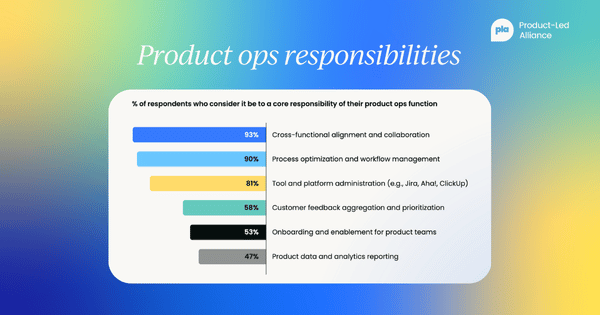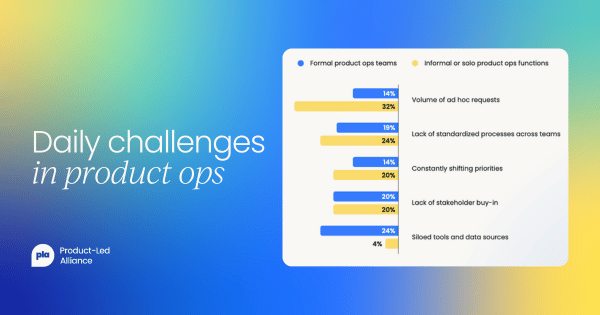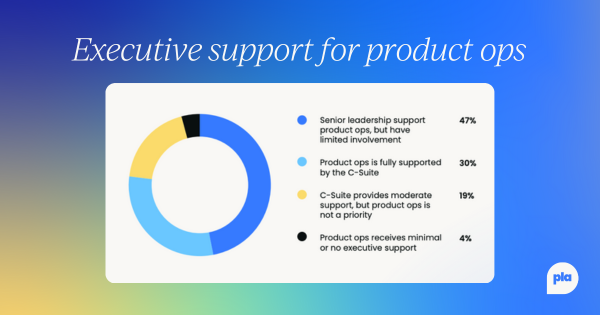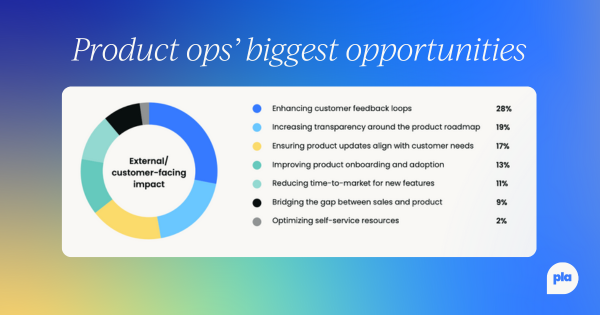If you work in product ops, you know the drill: your job description says “strategic planning,” but your Slack messages say “please fix the dashboard.” Between the tools, reports, and urgent requests, it’s easy to lose sight of the bigger picture.
That’s the paradox at the heart of product ops – the function built to bring clarity often runs on chaos. The State of Product Ops Report 2025 lays it out clearly: many teams are so busy keeping the engine running that there’s no time to chart the course ahead.
This article looks at what’s behind that imbalance – and how product ops can reclaim the time, structure, and influence it needs to drive long-term impact.
The current state: Where product ops spends its time
If your days feel like a blur of tool fixes and last-minute requests, you’re in good company. The latest State of Product Ops Report shows that most ops pros spend the bulk of their time in execution mode – keeping the machine running rather than strategizing on how to make it run better.
And that’s the crux of the problem. The same operational muscle that makes product ops so valuable can also keep it stuck in the weeds. Without time and space to think strategically, the function risks becoming a help desk for the product org instead of the engine that drives it forward.
The tactical foundation
There’s no doubt that product ops delivers real value. Nearly all survey respondents highlight cross-functional alignment and process optimization as their top priorities – work that’s essential to keeping the product organization running.
But success at the tactical level comes with a cost. Tool and platform administration absorbs a huge chunk of the available bandwidth, leaving little time for the strategic thinking that could redefine how teams operate.

Daily pain points
That tension plays out in every type of setup. 32% of solo operators are drowning in ad hoc requests, while 24% of dedicated product ops teams wrestle with siloed tools and data. Different challenges, same result: constant motion with little progress toward the bigger picture.

If product ops is ever going to move from tactical support to strategic leadership, something has to give.
The strategic capacity gap
So what happens when product ops spends all its time keeping things afloat? The strategic stuff slips through the cracks.
The report makes that clear: less than half of respondents (47%) see product data and analytics reporting as a core function. That’s staggering when you think about it – data is the fuel that powers smart decisions. If product ops isn’t owning it, who is?
That gap comes at a cost. Without ownership of data, ops teams struggle to connect their work to the metrics leadership cares about – revenue, retention, and growth. When your impact isn’t visible at that level, you stop looking like a strategic driver and start looking like overhead.
The knock-on effect? Stakeholder buy-in drops. Only 30% of product ops functions feel fully supported by the C-suite. It’s a vicious cycle: less visibility leads to less investment, which leaves even less time for the kind of work that earns visibility.

The takeaway is simple: without space for strategy, product ops can’t evolve. It ends up trapped in a loop of short-term fixes instead of repairing the systems that make those fixes necessary in the first place.
Building space for strategy
You can’t think long-term if your calendar’s packed wall-to-wall with short-term tasks. The answer isn’t to “work smarter” or “prioritize better.” It’s to redesign the system so strategy actually has room to happen.
That starts with how the function is built.
The power of a centralized product ops team
76% product ops teams are centralized (i.e., working across all product teams) – and for good reason. A central team sees the full picture. It can spot patterns, connect dots, and set standards that prevent problems before they start. That kind of visibility gives ops real strategic influence.

As Graham Reed, Head of Product Operations at HeliosX Group, puts it:
“This central way of working provides a holistic view to standardise and drive interoperability for all teams, and think more about how businesses see the product division – as one, not a set of teams. Silos are far easier to break down from the outside, and best practices can be shared easily.”
The strategic reporting line
Almost half of product ops teams report directly to the Chief Product Officer, and that’s a smart move. Sitting under the CPO keeps the function close to the product vision. It means day-to-day challenges are surfaced where long-term decisions get made.

When ops reports elsewhere – under engineering or general operations, say – that connection can fade. Insights lose their path to influence, and the function’s impact gets harder to see.
Structured collaboration
Strategy can’t thrive without structure. The data shows that 19% of centralized teams use dedicated product ops liaisons to partner with departments like sales, marketing, and engineering.
It’s a simple model, but a powerful one. That shift from reactive coordination to proactive partnership is what transforms ops from a supporting act into a strategic one.
Shifting from doing to driving
Once the right structure’s in place, product ops can focus on the kind of work that shapes how the business grows, not just how it runs. That shift starts with how success is measured, how automation is used, and how product ops connects with customers.
Measuring what matters
What you measure defines how you work. Many teams still track internal metrics like product team satisfaction (54%) or collaboration ratings (37%). These show value, but only within the product organization.
Strategic teams are starting to widen the lens. More are tracking customer retention and churn – 16% this year, up from 7% in 2023 – and tying their work to measurable business outcomes.

As Topher Fox, Director ot Product Operations at Aerospike, points out, it’s about shifting the focus to metrics that show how effectively insights turn into outcomes. If your work shortens the time it takes to identify a churn risk or improves how customer feedback shapes the roadmap, you’re operating at a strategic level.
Buying back time with automation
Only 7% of teams say they’re highly automated today, but nearly half expect AI and automation to define how the function evolves over the next three years.
When done well, automation frees product ops from repetitive tasks like report generation and tool administration. That time gets reinvested in design, insight, and strategy – the kind of work that can’t be delegated to a dashboard.
Owning the customer feedback loop
The biggest opportunity for product ops now sits outside the walls of the product org: customer feedback. 28% of respondents call it their top external focus for 2025.

Product ops is best positioned to design how feedback flows through the system – how it’s collected, standardized, and turned into actionable insights. It’s the bridge between what customers say and what the product team builds.
When product ops builds the system that transforms raw feedback into product features, it ensures that the roadmap reflects real customer needs. That alignment is where tactical effort turns into strategic value.
As Christian Marek, Product Leader at Vanta, points out:
“The path forward involves leveraging new technologies for workflow automation, deepening cross-functional alignment, enhancing customer feedback loops, and, most importantly, making sense of vast amounts of data with AI to ensure product decisions are tightly connected to customer needs and market demands.”
The path forward
The tension between the tactical and the strategic will never disappear – it’s part of the job. Product ops keeps the lights on, but it also shapes how the business grows. The challenge is making sure one doesn’t crowd out the other.
That balance starts with intention. You need to build structures that protect time for strategic work, connect the function directly to product leadership, and automate the busywork that eats into thinking time.
Most importantly, make strategy a habit, not a luxury. Use the data you manage to tell stories the business cares about – retention, growth, customer value.
When product ops links its daily work to outcomes that leadership can see, it earns a permanent place at the strategy table.

Want to learn more about the state of product ops in 2025? Get the full report for even more insights, data, and expert commentary.



 Follow us on LinkedIn
Follow us on LinkedIn



